Home weather station on esp8266 + aqara-xiaomi, part 2
Hello to all.
A year and a half has passed since I published my first article about my Home Weather Station project. During this time, I received numerous reviews from readers about the functionality and security of the system, as well as corrected a decent number of bugs that showed up when installing and deploying the system from other users (thanks to the most active users - HzXiO , enjoyneering , dimitriy16 ).
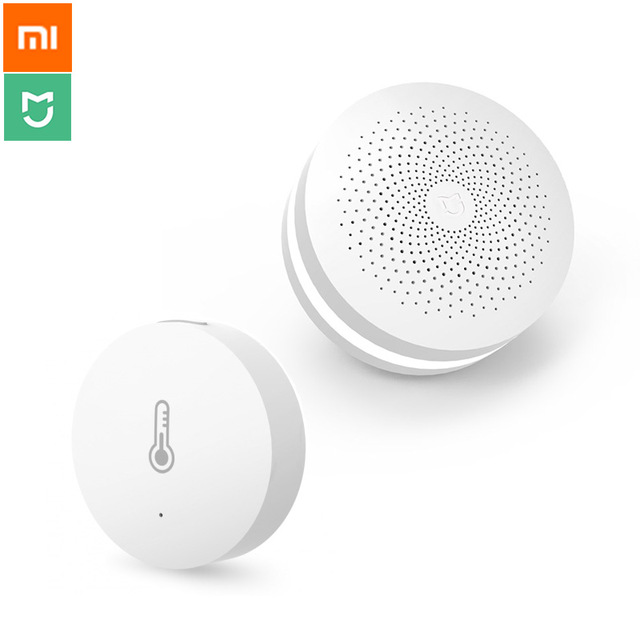
KDPV.
')
But this is all the lyrics, it's time to work!
So, what has been done in the new version of the system.
Iron part (on esp8266):
Server part (php + mysql):
I want to dwell on the most interesting tasks that had to be solved.
1. The program in the form of a footcloth of 1000+ lines of code has become completely unreadable, it became too difficult to navigate in this code, it became too difficult and time consuming to check and debug changes. Therefore, the code was rewritten - basic interfaces appeared, declaring standard methods for working with sensors and displays, their heirs appeared, implementing logic specific to specific models, as well as factories responsible for creating the necessary classes.
I will show by example:
Here it is announced that we have two sensors of the DHT22 type, connected to pins 2 and 0, and also arrays are declared for the wrapper classes above the sensors, and for the array of data obtained from them.
The display used is declared the same way - its type is set.
The initialization of sensors and display occurs in the setup method:
At each measurement cycle, data is received from the sensors and transferred to the display for display:
Actually, these small pieces of code - and could be the whole program, if not working with Wi-Fi or creating an access point on esp8266 to configure the modules.
As you can see, if the user needs to change the sensor used, or connect a new display, it will be very simple: you just need to register their types, and change the pin configuration.
If you need to add a new type of sensor or display, then you should create a descendant from the base class, and redefine the methods for obtaining data and drawing them.
2. Changes in security - now the access point created by the module has the password specified in the config when the module is flashed - no one else can connect to the module without the user's knowledge.
3. When drawing graphs on the site, the Kalman filter is now used to remove the bounce of values.
4. Now it is possible to control the visibility and names of the sensors on the modules - this can be done on the settings page of each module on the site.
5. The main feature added in this weather station revision is support for working with Aqara sensors for the Xiaomi smart home ecosystem.
To realize this opportunity, you will need: the gateway of the smart home, translated into developer mode, and the actual temperature and humidity sensors themselves. Sensors should be connected to the gateway through the MiHome application, then, the application and the great Chinese clouds can be forgotten: data exchange will take place within the local network, which you should put in the guest segment without Internet access at all.
In order to receive data transmitted between sensors and a gateway in the local network, I use Malinka in my project, on which the module written on nodejs is running. The module listens to multicast messages transmitted on the network, parses them to find the necessary sensors, since all data is transmitted in JSON format, and after searching for sensors, it extracts data on temperature and humidity from messages.
The data obtained in this way is sent to the site specified in the configuration file for further display and storage.
I will give the code of the module and the config - see under the cat:
To run the module on Malinka - the nodejs sensor.js command is used
How to automate the launch of the module at the start of Malinki - until you decide, probably someone will tell in the comments how to make it easier and more beautiful.
Type of data received from the Malinka console:
As you can see from the output, there are two sensors on the network, with identifiers 52585 and 20046. The data from them is sent to the server specified in the config (http://weatherhub.ru) - where the site itself and the database for storing data are picked up.
After launching the module, connecting sensors, and launching the website, new sensors can be immediately seen on the Settings page:
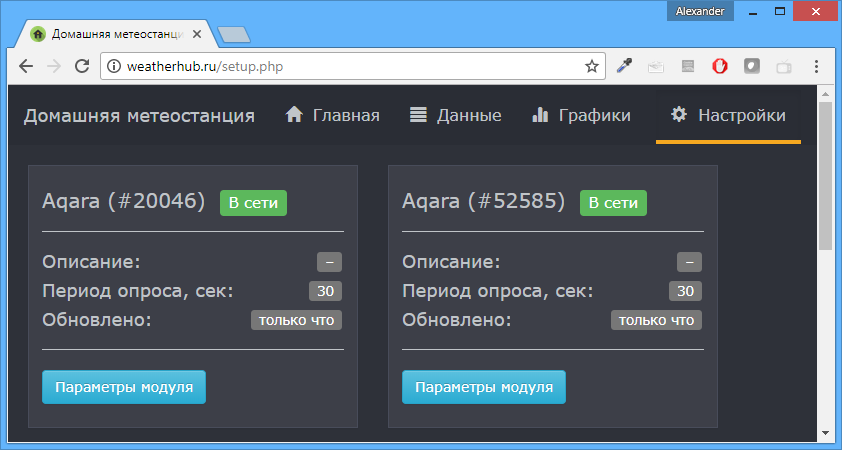
Using the Module Parameters button, we select active sensors (in our case, these are Temperature 1 and Humidity 1), save the data, and go to the Main, where we can see the received data:
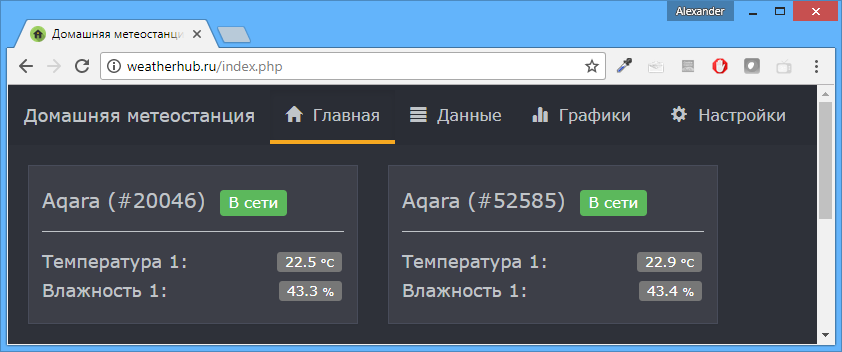
On the Data page, you can view the data from a table:
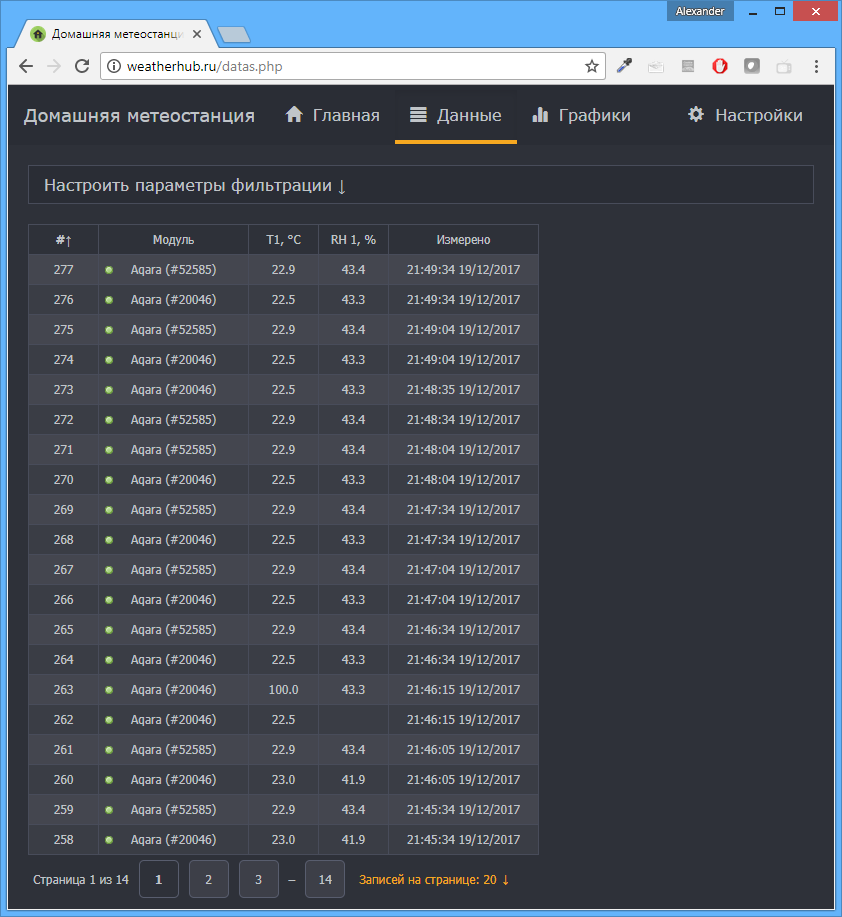
On the Charts page are charts for which you can choose the display period:
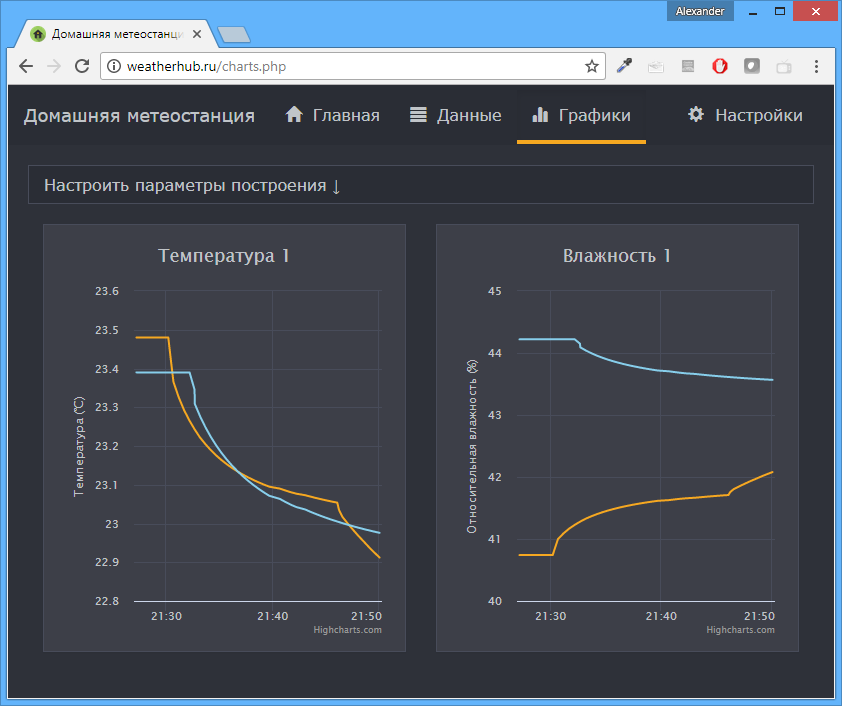
The site is running as a single user, without authorization. Therefore, the displayed data is available to all. When authorization is enabled, each user receives a unique validation code, which will need to be specified either in the firmware for the controller or in the nodejs module.
All weather station code is available on Github: github.com/aproschenko-dev/WeatherHub
Further development that I see:
From readers, I would like to hear in the comments criticism of the case, suggestions for the system, and - what would be most valuable - personal experience of deploying and using the system, including with the Aqara sensors, which have become quite inexpensive.
I am sure that when deploying and launching a meteorological station, many questions may arise - I am ready to give answers to them, and following the results - write a detailed manual on the system.
A year and a half has passed since I published my first article about my Home Weather Station project. During this time, I received numerous reviews from readers about the functionality and security of the system, as well as corrected a decent number of bugs that showed up when installing and deploying the system from other users (thanks to the most active users - HzXiO , enjoyneering , dimitriy16 ).

KDPV.
')
But this is all the lyrics, it's time to work!
So, what has been done in the new version of the system.
Iron part (on esp8266):
- The system code has been completely rewritten: now the OOP is widely used to work with sensors and displays in order to simplify the addition of new sensors as much as possible and to make the code understandable and structured
- Considered wishes regarding system security
- Simplified module setup pages
- Removed dependencies on RTC
Server part (php + mysql):
- Changed chart drawing algorithm - Kalman filter is used
- Each user of the system now sees only its own modules.
- You can give your names to the sensors, control their visibility on the pages.
- Added the ability to view data from temperature-humidity sensors manufactured by Aqara-Xiaomi.
I want to dwell on the most interesting tasks that had to be solved.
1. The program in the form of a footcloth of 1000+ lines of code has become completely unreadable, it became too difficult to navigate in this code, it became too difficult and time consuming to check and debug changes. Therefore, the code was rewritten - basic interfaces appeared, declaring standard methods for working with sensors and displays, their heirs appeared, implementing logic specific to specific models, as well as factories responsible for creating the necessary classes.
I will show by example:
#define sensorsCount 2 int sensorTypes[sensorsCount] = {SENSOR_DHT22, SENSOR_DHT22}; int sensorPins[sensorsCount] = {2, 0}; SensorEntity** sensorEntities; SensorOutputData* outputDatas; Here it is announced that we have two sensors of the DHT22 type, connected to pins 2 and 0, and also arrays are declared for the wrapper classes above the sensors, and for the array of data obtained from them.
DisplayEntity display = DisplayEntity(DISPLAY_LCD_I2C); The display used is declared the same way - its type is set.
The initialization of sensors and display occurs in the setup method:
void setupSensors() { outputDatas = new SensorOutputData[sensorsCount]; sensorEntities = new SensorEntity*[sensorsCount]; for (int i = 0; i < sensorsCount; i++) { int sensorType = sensorTypes[i]; int pin = sensorPins[i]; SensorEntity* entity = new SensorEntity(sensorType); entity->setup(pin); sensorEntities[i] = entity; } } void setupDisplay() { DisplayConfig displayConfig = DisplayConfig(); displayConfig.address = 0x27; displayConfig.rows = 2; displayConfig.cols = 16; displayConfig.sda = 4; displayConfig.scl = 5; displayConfig.printSensorTitle = false; display.setup(displayConfig); display.clear(); } At each measurement cycle, data is received from the sensors and transferred to the display for display:
void requestSensorValues() { for (int i = 0; i < sensorsCount; i++) { SensorEntity* entity = sensorEntities[i]; SensorOutputData sensorData = entity->getData(); sensorData.sensorOrder = i; outputDatas[i] = sensorData; } } void renderSensorValues() { for (int i = 0; i < sensorsCount; i++) { SensorOutputData sensorData = outputDatas[i]; display.printData(sensorData); } } Actually, these small pieces of code - and could be the whole program, if not working with Wi-Fi or creating an access point on esp8266 to configure the modules.
As you can see, if the user needs to change the sensor used, or connect a new display, it will be very simple: you just need to register their types, and change the pin configuration.
If you need to add a new type of sensor or display, then you should create a descendant from the base class, and redefine the methods for obtaining data and drawing them.
2. Changes in security - now the access point created by the module has the password specified in the config when the module is flashed - no one else can connect to the module without the user's knowledge.
3. When drawing graphs on the site, the Kalman filter is now used to remove the bounce of values.
4. Now it is possible to control the visibility and names of the sensors on the modules - this can be done on the settings page of each module on the site.
5. The main feature added in this weather station revision is support for working with Aqara sensors for the Xiaomi smart home ecosystem.
To realize this opportunity, you will need: the gateway of the smart home, translated into developer mode, and the actual temperature and humidity sensors themselves. Sensors should be connected to the gateway through the MiHome application, then, the application and the great Chinese clouds can be forgotten: data exchange will take place within the local network, which you should put in the guest segment without Internet access at all.
In order to receive data transmitted between sensors and a gateway in the local network, I use Malinka in my project, on which the module written on nodejs is running. The module listens to multicast messages transmitted on the network, parses them to find the necessary sensors, since all data is transmitted in JSON format, and after searching for sensors, it extracts data on temperature and humidity from messages.
The data obtained in this way is sent to the site specified in the configuration file for further display and storage.
I will give the code of the module and the config - see under the cat:
Module and config on nodejs
Module:
Config:
var request = require("request"); var config = require('./config'); const dgram = require('dgram'); const serverPort = config.serverPort; const serverSocket = dgram.createSocket('udp4'); const multicastAddress = config.multicastAddress; const multicastPort = config.multicastPort; const sensorDelay = config.sensorDelay; var sidToAddress = {}; var sidToPort = {}; var gatewayAddress; function sendSensorData(sensorId, temperature, humidity, gatewayAddress) { request({ url: config.addDataUrl, method: 'GET', qs: { isaqara: 1, moduleid: sensorId, modulename: sensorId, code: config.validationCode, temperature1: temperature, humidity1: humidity, ip: gatewayAddress, mac: sensorId, delay: sensorDelay } }, function (error, response, body) { if (error) { console.log(error); } } ); } serverSocket.on('message', function (msg, rinfo) { console.log('Received \x1b[33m%s\x1b[0m (%d bytes) from client \x1b[36m%s:%d\x1b[0m.', msg, msg.length, rinfo.address, rinfo.port); var json; try { json = JSON.parse(msg); } catch (e) { console.log('\x1b[31mUnexpected message: %s\x1b[0m.', msg); return; } var cmd = json['cmd']; if (cmd === 'iam') { var address = json['ip']; var port = json['port']; gatewayAddress = address; var command = { cmd: "get_id_list" }; var cmdString = JSON.stringify(command); var message = new Buffer(cmdString); serverSocket.send(message, 0, cmdString.length, port, address); console.log('Requesting devices list...'); } else if (cmd === 'get_id_list_ack') { var data = JSON.parse(json['data']); console.log('Received devices list: %d device(s) connected.', data.length); for (var index in data) { var sid = data[index]; var command = { cmd: "read", sid: new String(sid) }; sidToAddress[sid] = rinfo.address; sidToPort[sid] = rinfo.port; var cmdString = JSON.stringify(command); var message = new Buffer(cmdString); serverSocket.send(message, 0, cmdString.length, rinfo.port, rinfo.address); console.log('Sending \x1b[33m%s\x1b[0m to \x1b[36m%s:%d\x1b[0m.', cmdString, rinfo.address, rinfo.port); } } else if (cmd === 'read_ack' || cmd === 'report' || cmd === 'heartbeat') { var model = json['model']; var data = JSON.parse(json['data']); if (model === 'sensor_ht') { var temperature = data['temperature'] ? data['temperature'] / 100.0 : 100; var humidity = data['humidity'] ? data['humidity'] / 100.0 : 0; var sensorId = json["short_id"]; console.log("Received data from sensor \x1b[31m%s\x1b[0m (sensorId: %s) data: temperature %d, humidity %d.", json['sid'], sensorId, temperature, humidity); sendSensorData(sensorId, temperature, humidity, gatewayAddress); console.log('Sending sensor data to \x1b[36m%s\x1b[0m.', config.addDataUrl); } } }); // err - Error object, https://nodejs.org/api/errors.html serverSocket.on('error', function (err) { console.log('Error, message - %s, stack - %s.', err.message, err.stack); }); serverSocket.on('listening', function () { console.log('Starting a UDP server, listening on port %d.', serverPort); serverSocket.addMembership(multicastAddress); }) console.log('Starting Aqara daemon...'); serverSocket.bind(serverPort); function sendWhois() { var command = { cmd: "whois" }; var cmdString = JSON.stringify(command); var message = new Buffer(cmdString); serverSocket.send(message, 0, cmdString.length, multicastPort, multicastAddress); console.log('Sending WhoIs request to a multicast address \x1b[36m%s:%d\x1b[0m.', multicastAddress, multicastPort); } sendWhois(); setInterval(function () { console.log('Requesting data...'); sendWhois(); }, sensorDelay * 1000); Config:
var config = { validationCode: "0000000000000000", addDataUrl: "http://weatherhub.ru/aqara.php", serverPort: 9898, multicastAddress: '224.0.0.50', multicastPort: 4321, sensorDelay: 30 }; module.exports = config; To run the module on Malinka - the nodejs sensor.js command is used
How to automate the launch of the module at the start of Malinki - until you decide, probably someone will tell in the comments how to make it easier and more beautiful.
Type of data received from the Malinka console:
Received data
root@raspberrypi:/home/nodejs# nodejs sensor.js Starting Aqara daemon... Sending WhoIs request to a multicast address 224.0.0.50:4321. Starting a UDP server, listening on port 9898. Received {"cmd":"iam","port":"9898","sid":"f0b429cc178e","model":"gateway","ip":"192.168.1.112"} (87 bytes) from client 192.168.1.112:4321. Requesting devices list... Received {"cmd":"get_id_list_ack","sid":"f0b429cc178e","token":"GVke0tYsRZ5zlXWc","data":"[\"158d00015b2f98\",\"158d0001560c23\",\"158d00013eccc6\",\"158d000153db73\",\"158d000127883b\",\"158d0001581523\",\"158d0001101d54\"]"} (217 bytes) from client 192.168.1.112:9898. Received devices list: 7 device(s) connected. Sending {"cmd":"read","sid":"158d00015b2f98"} to 192.168.1.112:9898. Sending {"cmd":"read","sid":"158d0001560c23"} to 192.168.1.112:9898. Sending {"cmd":"read","sid":"158d00013eccc6"} to 192.168.1.112:9898. Sending {"cmd":"read","sid":"158d000153db73"} to 192.168.1.112:9898. Sending {"cmd":"read","sid":"158d000127883b"} to 192.168.1.112:9898. Sending {"cmd":"read","sid":"158d0001581523"} to 192.168.1.112:9898. Sending {"cmd":"read","sid":"158d0001101d54"} to 192.168.1.112:9898. Received {"cmd":"read_ack","model":"sensor_ht","sid":"158d00015b2f98","short_id":20046,"data":"{\"voltage\":2975,\"temperature\":\"2297\",\"humidity\":\"4190\"}"} (153 bytes) from client 192.168.1.112:9898. Received data from sensor 158d00015b2f98 (sensorId: 20046) data: temperature 22.97, humidity 41.9. Sending sensor data to http://weatherhub.ru/aqara.php. Received {"cmd":"read_ack","model":"motion","sid":"158d0001560c23","short_id":41212,"data":"{\"voltage\":3075}"} (103 bytes) from client 192.168.1.112:9898. Received {"cmd":"read_ack","model":"switch","sid":"158d00013eccc6","short_id":4019,"data":"{\"voltage\":3042}"} (102 bytes) from client 192.168.1.112:9898. Received {"cmd":"read_ack","model":"magnet","sid":"158d000153db73","short_id":4914,"data":"{\"voltage\":3015,\"status\":\"unknown\"}"} (125 bytes) from client 192.168.1.112:9898. Received {"cmd":"read_ack","model":"plug","sid":"158d000127883b","short_id":52305,"data":"{\"voltage\":3600,\"status\":\"unknown\",\"inuse\":\"0\"}"} (140 bytes) from client 192.168.1.112:9898. Received {"cmd":"read_ack","model":"sensor_ht","sid":"158d0001581523","short_id":52585,"data":"{\"voltage\":3035,\"temperature\":\"2287\",\"humidity\":\"4340\"}"} (153 bytes) from client 192.168.1.112:9898. Received data from sensor 158d0001581523 (sensorId: 52585) data: temperature 22.87, humidity 43.4. Sending sensor data to http://weatherhub.ru/aqara.php. Received {"cmd":"read_ack","model":"switch","sid":"158d0001101d54","short_id":3344,"data":"{\"voltage\":3032}"} (102 bytes) from client 192.168.1.112:9898. Received {"cmd":"heartbeat","model":"gateway","sid":"f0b429cc178e","short_id":"0","token":"oypMd4l87xHIR6oP","data":"{\"ip\":\"192.168.1.112\"}"} (136 bytes) from client 192.168.1.112:4321. ", "sid": "f0b429cc178e", "token": "GVke0tYsRZ5zlXWc", "data": "[\" 158d00015b2f98 \ ", \" 158d0001560c23 \ ", \" 158d00013eccc6 \ ", root@raspberrypi:/home/nodejs# nodejs sensor.js Starting Aqara daemon... Sending WhoIs request to a multicast address 224.0.0.50:4321. Starting a UDP server, listening on port 9898. Received {"cmd":"iam","port":"9898","sid":"f0b429cc178e","model":"gateway","ip":"192.168.1.112"} (87 bytes) from client 192.168.1.112:4321. Requesting devices list... Received {"cmd":"get_id_list_ack","sid":"f0b429cc178e","token":"GVke0tYsRZ5zlXWc","data":"[\"158d00015b2f98\",\"158d0001560c23\",\"158d00013eccc6\",\"158d000153db73\",\"158d000127883b\",\"158d0001581523\",\"158d0001101d54\"]"} (217 bytes) from client 192.168.1.112:9898. Received devices list: 7 device(s) connected. Sending {"cmd":"read","sid":"158d00015b2f98"} to 192.168.1.112:9898. Sending {"cmd":"read","sid":"158d0001560c23"} to 192.168.1.112:9898. Sending {"cmd":"read","sid":"158d00013eccc6"} to 192.168.1.112:9898. Sending {"cmd":"read","sid":"158d000153db73"} to 192.168.1.112:9898. Sending {"cmd":"read","sid":"158d000127883b"} to 192.168.1.112:9898. Sending {"cmd":"read","sid":"158d0001581523"} to 192.168.1.112:9898. Sending {"cmd":"read","sid":"158d0001101d54"} to 192.168.1.112:9898. Received {"cmd":"read_ack","model":"sensor_ht","sid":"158d00015b2f98","short_id":20046,"data":"{\"voltage\":2975,\"temperature\":\"2297\",\"humidity\":\"4190\"}"} (153 bytes) from client 192.168.1.112:9898. Received data from sensor 158d00015b2f98 (sensorId: 20046) data: temperature 22.97, humidity 41.9. Sending sensor data to http://weatherhub.ru/aqara.php. Received {"cmd":"read_ack","model":"motion","sid":"158d0001560c23","short_id":41212,"data":"{\"voltage\":3075}"} (103 bytes) from client 192.168.1.112:9898. Received {"cmd":"read_ack","model":"switch","sid":"158d00013eccc6","short_id":4019,"data":"{\"voltage\":3042}"} (102 bytes) from client 192.168.1.112:9898. Received {"cmd":"read_ack","model":"magnet","sid":"158d000153db73","short_id":4914,"data":"{\"voltage\":3015,\"status\":\"unknown\"}"} (125 bytes) from client 192.168.1.112:9898. Received {"cmd":"read_ack","model":"plug","sid":"158d000127883b","short_id":52305,"data":"{\"voltage\":3600,\"status\":\"unknown\",\"inuse\":\"0\"}"} (140 bytes) from client 192.168.1.112:9898. Received {"cmd":"read_ack","model":"sensor_ht","sid":"158d0001581523","short_id":52585,"data":"{\"voltage\":3035,\"temperature\":\"2287\",\"humidity\":\"4340\"}"} (153 bytes) from client 192.168.1.112:9898. Received data from sensor 158d0001581523 (sensorId: 52585) data: temperature 22.87, humidity 43.4. Sending sensor data to http://weatherhub.ru/aqara.php. Received {"cmd":"read_ack","model":"switch","sid":"158d0001101d54","short_id":3344,"data":"{\"voltage\":3032}"} (102 bytes) from client 192.168.1.112:9898. Received {"cmd":"heartbeat","model":"gateway","sid":"f0b429cc178e","short_id":"0","token":"oypMd4l87xHIR6oP","data":"{\"ip\":\"192.168.1.112\"}"} (136 bytes) from client 192.168.1.112:4321. As you can see from the output, there are two sensors on the network, with identifiers 52585 and 20046. The data from them is sent to the server specified in the config (http://weatherhub.ru) - where the site itself and the database for storing data are picked up.
After launching the module, connecting sensors, and launching the website, new sensors can be immediately seen on the Settings page:

Using the Module Parameters button, we select active sensors (in our case, these are Temperature 1 and Humidity 1), save the data, and go to the Main, where we can see the received data:

On the Data page, you can view the data from a table:

On the Charts page are charts for which you can choose the display period:

The site is running as a single user, without authorization. Therefore, the displayed data is available to all. When authorization is enabled, each user receives a unique validation code, which will need to be specified either in the firmware for the controller or in the nodejs module.
All weather station code is available on Github: github.com/aproschenko-dev/WeatherHub
Further development that I see:
- The ability to display data in a graphical form, in the form of a scale
- Adding the most common models to the standard set of supported sensors - bme280, bmp280 and others
- CO2 Sensor Support - MHT-Z19
From readers, I would like to hear in the comments criticism of the case, suggestions for the system, and - what would be most valuable - personal experience of deploying and using the system, including with the Aqara sensors, which have become quite inexpensive.
I am sure that when deploying and launching a meteorological station, many questions may arise - I am ready to give answers to them, and following the results - write a detailed manual on the system.
Source: https://habr.com/ru/post/370999/
All Articles